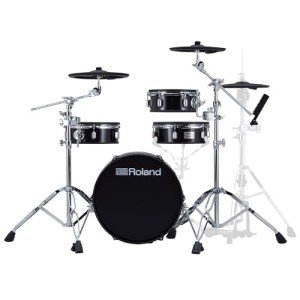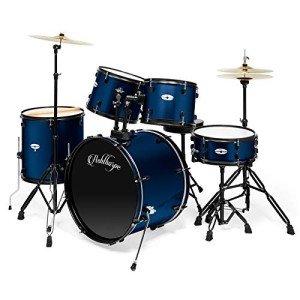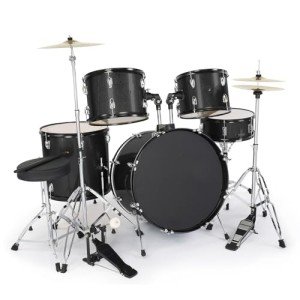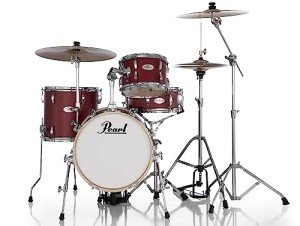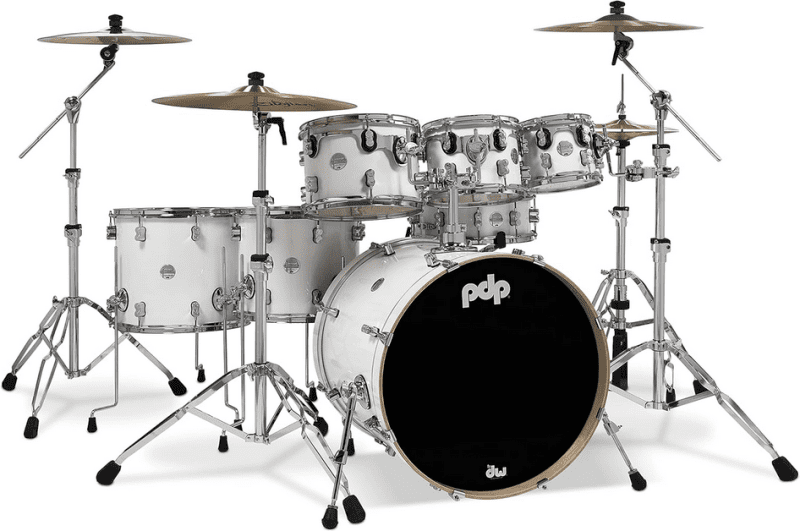Drum fills and solos are some of the most exciting parts of playing the drums, but let’s be honest—they can feel tricky to get right. Learning how to create smooth, dynamic fills and solos can really breathe new life and energy into your music. With good techniques and a bit of focused practice, you can start playing patterns that just click with whatever song you’re working on.

This article aims to break down what makes a killer drum fill, show you how to build your chops with simple exercises, and help you shape solos that feel like your own. You’ll also find some tips on listening, reading notation, and using drum fills and solos to make your playing stand out on any stage.
Key Takeaways
- Figure out what makes drum fills and solos pop
- Build solid skills with straightforward techniques
- Use fills and solos to boost the energy and vibe of songs
Understanding Drum Fills and Solos
Drum fills and solos matter for every drummer. They connect song sections, show off creativity, and add excitement. If you get these techniques down, it really changes your playing.
What Are Drum Fills?
Drum fills are short, sometimes improvised patterns that bridge parts of a song. You’ll hear them between verses and choruses or leading into a solo. Most fills last a measure or two, but that can shift depending on the genre.
Fills usually bounce around the kit, mixing drums and cymbals. They might be super simple—just snare and bass—or more involved, with toms, hi-hats, and crashes thrown in. If you’re just starting out, basic rock fills are a solid starting point since they stick to steady rhythms.
You’ll hear fills in rock, funk, jazz, and blues. Listening to great drummers in each genre really shows how fills can fit into different styles.
What Makes a Drum Solo?
A drum solo is a spot where the drummer steps out front—sometimes alone, sometimes just above the rest of the band. Solos are a chance to show off skill, creativity, and timing. They’re usually longer than fills, giving you room to experiment with patterns, dynamics, and speed.
Some solos are planned out, others just happen in the moment. In jazz and blues, solos might riff on earlier themes. In rock or funk, they can get wild, using the whole kit.
The best solos keep people listening by mixing up rhythms and sounds. Drummers who focus on good timing and musical ideas—rather than just going fast or loud—usually connect better with the audience.
The Role of Fills and Solos in Different Genres
Fills and solos definitely shift depending on the style. In rock, fills are often straightforward and loud—pushing the band from one section to another. Rock drum solos? Those are usually the big, showy moments live.
Funk drummers keep fills tight and syncopated. Solos in funk don’t happen as much, and when they do, it’s all about the groove. Jazz and blues go for more complex fills, sometimes played softly or with brushes. Jazz solos can get long and often play off the rest of the band.
Here’s a quick rundown:
| Genre | Fills | Solos |
|---|---|---|
| Rock | Powerful and direct | Loud, energetic, crowd-pleasing |
| Funk | Tight, syncopated | Focus on groove, less frequent |
| Jazz | Complex, uses dynamics | Improvised, often interactive |
| Blues | Simple but expressive | Short, supports melody |
It’s worth listening closely to whatever genre you’re playing. Picking fills and solos that fit the style makes you a better bandmate and a more versatile drummer.
Building Fundamental Techniques

If you want to nail drum fills and solos, start with the basics: drum rudiments and solid hand-foot coordination. These give you the tools to move around the kit smoothly and make your fills sound clean.
Mastering Rudiments
Drum rudiments are the basic sticking patterns that drummers use everywhere. Some of the big ones:
- Single stroke roll (RLRL...)
- Double stroke roll (RRLL...)
- Paradiddle (RLRR LRLL)
Practicing these on a snare drum helps you build control and speed. If you’re new, grab a metronome and start slow. Bumping up the tempo bit by bit helps your hands stay consistent.
But don’t just stick to the snare—take those rudiments around the kit. Move patterns between toms, snare, and cymbals. That’s where fills start sounding musical, not robotic.
Developing Hand and Foot Coordination
Great fills and solos need your hands and feet working together. Practice patterns between your hands and the bass drum.
Try playing simple hand rhythms on the snare while keeping a steady bass drum pulse. Or add the hi-hat or ride with your foot for some extra flavor.
Switching strokes between hands and feet—like snare to bass drum—helps you move around the kit without getting stuck. The more you practice this, the more creative your fills get.
It’s not always easy, but working your hands and feet together builds confidence and makes your fills flow better.
Practicing Fills: From Basic to Advanced
Practicing fills is where you build up control, speed, and creativity. Each level gives you new ideas and skills to use in your playing.
Basic Drum Fill Patterns
Start with basic fills for a solid foundation. Simple fills use single-stroke rolls or alternate between snare and toms. Count out loud and keep the beat steady. Most basic fills take up one measure—think 1-2-3-4 in 4/4 time.
One easy exercise: play four beats on the snare or move eighth notes between the snare and high tom. Go slow, make sure your hands are even, and use a metronome if you can. Learning to read simple drum notation for these fills is a bonus.
Example:
| Beat | 1 | 2 | 3 | 4 |
|---|---|---|---|---|
| Hand | Snare | Tom 1 | Tom 2 | Snare |
Intermediate Fills for Versatility
Intermediate fills mix it up—throw in triplets, use more drums, and add some bass drum. Try combining rolls with accents, or start and end fills off the main beats for a challenge.
Practicing fills in different time signatures keeps you on your toes. Some good drills: play sixteenth note fills with accents on different drums, or move fills across the snare, toms, and cymbals. Change up the tempo and style (rock, funk, jazz) to grow your vocabulary. Listen for how fills drop back into the groove.
Advanced Techniques for Professional Fills
Advanced fills bring in complex rhythms, fast rolls, odd groupings, and tough coordination between hands and feet. Pros mix in flams, drags, and double strokes. Some use polyrhythms or shift fills so they don’t always land on the downbeat.
At this stage, you’ll want to play clean, even noteseven when you speed things up. Practice solos that cover the whole kit for more control. Try reading written drum notation for tricky fills, or figure out fills by ear from your favorite recordings. Playing with dynamics and exploring new sounds makes your fills musical and helps them fit any genre.
Creating Expressive Drum Solos
If you want your drum solos to stand out, think about structure, mix up your dynamics, and pay attention to what’s happening in the music. Building in creativity and musicality makes every solo a little different—and way more interesting.
Structuring Your Solo
A good solo has a shape people can follow. Most start simple and get more complex. For example, you might begin with basic rhythms on one drum, then add more drums and cymbals as you go.
Some drummers like a theme and variation approach: they play a simple idea, repeat it, and tweak it each time.
Common Solo Structure:
| Section | Focus |
|---|---|
| Introduction | Simple patterns |
| Build-Up | Add speed or more drums |
| Climax | Play loud, energetic ideas |
| Ending | Slow down, simple finish |
Having some kind of structure keeps you focused and makes it easier for people to listen along.
Incorporating Dynamics and Creativity
Using dynamics means you play some parts softer and others louder. Great solos bounce between these levels—maybe you’re tapping lightly on the snare, then suddenly smashing a cymbal. That kind of contrast keeps things interesting.
Creativity comes from messing around with new sounds. Try brushes or mallets if you want a different feel. Borrowing ideas from other songs or even other instruments can make your solo stand out.
Tips for Dynamic Solos:
- Switch up volume and speed
- Experiment with sticking patterns
- Throw in some unexpected pauses or stops
When you mix up dynamics and get creative, people actually pay attention—and your personality comes through in the playing.
Soloing with Musicality
Musical solos fit the song. It’s not just about playing fast. You have to listen. The drummer listens to the melody, chord changes, or what the other instruments are doing, and tries to match the mood.
Sometimes drummers play call-and-response with themselves or the band, repeating a rhythm and tweaking it. Leaving space between notes matters, too. You’ve got to keep time and know when to back off.
Integrating Fills and Solos Into Songs
Adding drum fills and solos isn’t just about showing off skills. The drummer has to pay attention to the band, the genre, and the whole vibe to make every fill and solo feel natural and fun.
Working with Other Musicians
When you play with others, timing and listening really matter. Watch for cues—maybe the guitarist is about to solo—and drop fills into spaces where they won’t clash with what’s going on.
Communication keeps everyone together. Bands like The Beatles made sure their drum fills worked with the music instead of pulling focus from the guitar or vocals. Use eye contact and body language to stay in sync.
Keep an ear on volume and dynamics. Don’t let your fills drown out the group. Lighter strokes work better under a soft vocal or gentle guitar, and you can save the big, wild fills for the louder parts.
Adapting to Genres and Styles
Every music style wants something different. Rock calls for bold, direct fills. Jazz? Softer, trickier rhythms. Drummers need to know what fits each style and when to keep things simple.
Pop songs—think The Beatles—use short, catchy fills that keep things moving. Dance and funk need more syncopation and tight fills that lock in with the bass. Blues or classic rock fills should add some flavor but not steal the spotlight from the solo or vocals.
If you can adjust your fills and solos for different genres, you’ll always be ready for whatever comes your way. The band sounds more together, and everyone gets to shine.
Improving Listening and Notation Skills
Focused listening and good notation help drummers break down tricky fills and solos. Learning to study and write drum parts gives you more tools for creativity and control.
Transcribing Legendary Drum Performances
When transcribing drums, you listen closely to recordings and write down the rhythms. Lots of drummers start with classic songs—like The Beatles—to pick up essential patterns and tricks.
It helps to slow down tracks using apps or software. That way, you can catch every note and accent. Write down what you hear with standard drum notation or just simple note values to keep things organized.
Notice details like which hand hits which drum, or when the hi-hat opens. Compare your notes to the recording and tweak them if something sounds off. Going back over your transcriptions later can spark new ideas for your own drumming.
Applying Notation in Practice
Drum notation lets you see patterns before you play them. Writing out fills and solos as sheet music or quick sketches helps you spot mistakes and tighten up your timing.
Use a practice pad or metronome when playing notated rhythms. Start slow and speed up as you get comfortable. Check off sections as you nail them.
Here’s a quick notation checklist:
- Pick a short fill or solo to notate.
- Write out each part (snare, kick, toms).
- Mark tough spots for extra work.
- Play it back and compare to the original.
Working with notation every practice session makes your ideas easier to remember, share, and actually play.
Frequently Asked Questions
Drum fills and solos need both technical chops and creative thinking. Beginners usually want methods, practice materials, and advice about realistic timelines and skill progression.
What are some essential drum fill techniques for beginners to learn?
Start with simple single strokes (right-left-right-left) on the snare and toms. Paradiddles and other basic sticking patterns are great too.
Work on playing fills in time and getting back to the beat smoothly. Go slow, use a metronome, and you’ll build confidence and accuracy.
Where can I find comprehensive sheet music for practicing drum fills and solos?
Look for drum books or online resources like Drumeo or Musiversity. Tons of websites have downloadable PDFs and video demos for practice.
Music stores and libraries usually have print books with graded drum exercises. Drummers also share their fills on forums and social media.
How long, on average, does it take to become proficient in drum fills and solos?
It usually takes a few months to feel comfortable with basic fills, and getting good at solos can take over a year of steady practice.
Progress depends on how much you practice, if you have a teacher, and your natural sense of rhythm. Practicing a bit every day works way better than cramming once a week.
What are the most challenging drum skills to master, including fills and solos?
Advanced fills with odd groupings, fast tempos, or tricky sticking are tough. Improvising new fills and solos on the spot can be a real challenge.
Mastering polyrhythms, dynamic control, and independence between hands and feet takes time. Playing cleanly at high speeds? That’s something the pros still work on for years.
Is there an age limit to learning and mastering drum fills and solos effectively?
No real age limit here. Kids and adults can both start learning drum fills and solos, and everyone can get better with practice.
Physical comfort and patience help at any age. Adults might take a bit longer initially, but determination and regular practice make a big difference.
Can you recommend any resources or samples for drum fills suitable for novice drummers?
You'll find many beginner-friendly drum fill tutorials and play-along tracks on Drumeo, Musiversity, and YouTube. Music education sites and forums usually have simple sheet music you can grab, too.
Listening to how drummers use fills in real songs can teach you a lot. If you're stuck or want fresh ideas, check out Reddit's r/drums—people there love sharing advice and fill suggestions you can mess around with at home.
DISCLAIMER
This document is provided for general information purposes only and should not be relied upon as providing legal advice, technical, or specific operational guidance to the reader, whether as to the practices described in the document or the applicable legal requirements and regulations. Percussion Pros. Com expressly disclaims any responsibility for liability arising from or related to the use or misuse of any information in this document.

